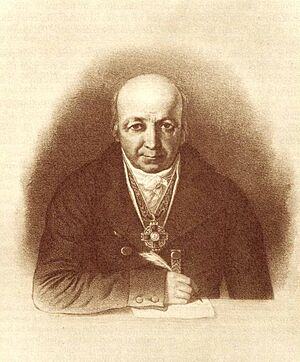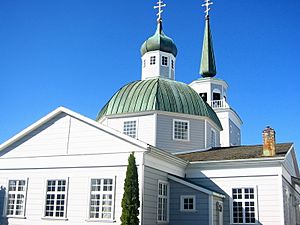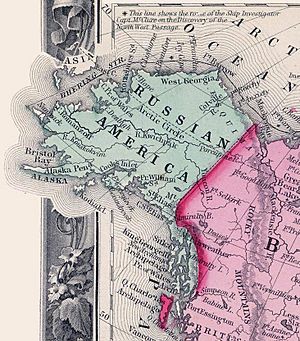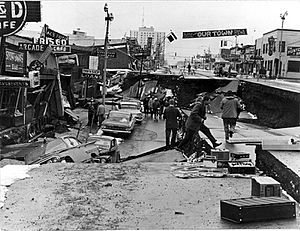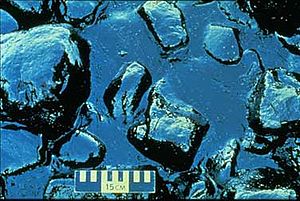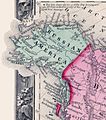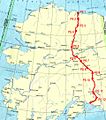North to the Future facts for kids
North to the Future is the official motto of Alaska. It was chosen in 1967. This motto represents Alaska's unique location far north and its spirit of always looking forward to a bright future. It reminds everyone that Alaska is a place of growth and new possibilities.
Contents
Welcome to Alaska!
Alaska is the largest state in the United States by land area. It is located in the far northwest part of North America. Alaska is known for its incredible natural beauty, including huge mountains, vast forests, and a long coastline. It is a land of extreme weather, from long, dark winters to summers with almost constant daylight.
A Land of Many Cultures
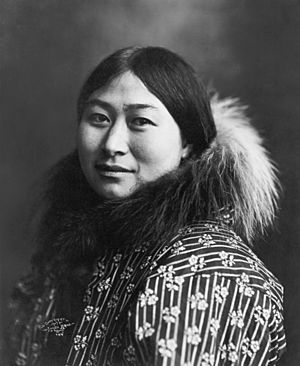
For thousands of years, different groups of indigenous peoples have lived in Alaska. These include the Iñupiat, Yup'ik, Aleut, Athabascan, Tlingit, Haida, and Tsimshian peoples. They developed rich cultures and ways of life that were perfectly suited to the Alaskan environment. They were skilled hunters, fishers, and artists.
Early Explorers and Russian Rule
The first Europeans to explore Alaska were from Russia in the 18th century. They were mainly interested in the fur trade, especially for sea otter pelts. Russia established settlements and trading posts along the coast. A very important person during this time was Alexandr Baranov, who managed the Russian-American Company and helped expand Russian influence.
The Russian presence also brought the Russian Orthodox Church to Alaska. Many Alaskan Natives adopted the Orthodox faith, and beautiful churches were built. Some of these historic churches, like St. Michael's Cathedral in Sitka, are still important landmarks today.
Other European nations, like Spain and Great Britain, also explored the Alaskan coast. They were looking for new trade routes and resources. However, Russia remained the main European power in the region for many years.
The Alaska Purchase
By the mid-1800s, Russia found it difficult and expensive to manage its distant Alaskan territory. So, in 1867, the United States agreed to buy Alaska from Russia. The deal was made by U.S. Secretary of State William H. Seward. The price was $7.2 million, which was about two cents per acre.
At the time, many Americans thought buying Alaska was a bad idea. They called it "Seward's Folly" or "Seward's Icebox" because they believed it was just a frozen wasteland. However, this purchase turned out to be one of the best deals in history, as Alaska proved to be rich in natural resources.
Gold Rush and Growth
A major event that changed Alaska was the Klondike Gold Rush in the late 1890s. Although the main gold fields were in Canada's Yukon Territory, thousands of prospectors traveled through Alaska to get there. This brought many new people to Alaska and led to the growth of towns like Skagway and Nome. The gold rush helped people realize Alaska's potential and led to more exploration and development.
Modern Alaska: Challenges and Progress
Alaska officially became the 49th U.S. state on January 3, 1959. Since then, it has continued to grow and develop, facing both challenges and opportunities.
Earthquakes and Resilience
Alaska is located in an active earthquake zone. On March 27, 1964, Alaska experienced one of the strongest earthquakes ever recorded. Known as the Good Friday Earthquake, it caused widespread damage, especially in Anchorage. Despite the destruction, Alaskans showed great strength and worked together to rebuild their communities. This event highlighted the importance of building strong, earthquake-resistant structures.
The Oil Industry
In 1968, a huge oil field was discovered at Prudhoe Bay on Alaska's North Slope. This discovery led to the construction of the Trans-Alaska Pipeline System, a massive pipeline built to transport oil across the state to the port of Valdez. The pipeline was a huge engineering project and began operating in 1977.
The oil industry has played a very important role in Alaska's economy. It has provided jobs and revenue for the state. However, it has also brought environmental concerns.
In 1989, the Exxon Valdez oil spill occurred in Prince William Sound. This was a major environmental disaster that caused a lot of damage to the ecosystem. Since then, there have been many efforts to improve oil spill prevention and response. This event also led to a greater focus on protecting Alaska's unique natural environment.
Looking to the Future
Today, Alaska continues to look "North to the Future." It is a state that balances its rich natural resources with a strong commitment to protecting its environment. Alaska is also a center for scientific research, especially related to climate change and Arctic studies. Its unique location and vast wilderness make it a special place with a promising future.
Images for kids
-
Alaska in 1895 (Rand McNally). The boundary of southeastern Alaska shown is that claimed by the United States prior to the conclusion of the Alaska boundary dispute.
-
An Inupiaq woman, Nome, Alaska, c. 1907.
-
St. Michael's Cathedral in Sitka. The original structure, built in 1848, burned in a fire on January 2, 1966. The cathedral was rebuilt from plans of the original structure and contains artifacts rescued from the fire.
-
Miners and prospectors climb the Chilkoot Trail during the Klondike Gold Rush.



